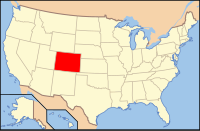Kiowa County, Colorado
| Kiowa County, Colorado | |
|---|---|

Kiowa County Courthouse, 1903
|
|
 Location in the U.S. state of Colorado |
|
 Colorado's location in the U.S. |
|
| Founded | April 11, 1889 |
| Named for | Kiowa Nation |
| Seat | Eads |
| Largest town | Eads |
| Area | |
| • Total | 1,786 sq mi (4,626 km2) |
| • Land | 1,768 sq mi (4,579 km2) |
| • Water | 18 sq mi (47 km2), 1.0% |
| Population (est.) | |
| • (2015) | 1,423 |
| • Density | 0.8/sq mi (0/km²) |
| Congressional district | 4th |
| Time zone | Mountain: UTC-7/-6 |
| Website | www |
Kiowa County is one of the 64 counties in the U.S. state of Colorado. As of the 2010 census, the population was 1,398, making it the fifth-least populous county in Colorado. The county seat is Eads. The county was named for the Kiowa Nation of Native Americans.
On November 29, 1864, more than a decade before Colorado became a state and long before Kiowa County was formed, a massacre of Native Americans, a group of old men, women, and children, occurred on Sand Creek that initially was greeted as a victory in the Colorado War against hostile Indians; within months, Congressional inquiries revealed the truth, and a national scandal erupted. It happened in what is now Kiowa County, and is known as the Sand Creek Massacre.
Territorial Governor John Evans eventually lost his job for his part in setting up the incident, and Colonel John Chivington, commander of the U.S. forces, was castigated by the United States Congress and the scandal followed him for the rest of his life. Evans would go on to make significant important contributions to the early Denver community and while Chivington also made some, his reputation remained tainted while Evans is still honored today.
In 2005, final land acquisitions by the National Park Service allowed official designation of the Sand Creek Massacre National Historic Site, but no park facilities have yet been erected. Only a plaque in the ground acknowledges the site, and it appears that this stone plaque is located in the wrong place.
In the late 1880s, eastern Colorado attracted a lot of attention by farming interests who didn't yet know that long-term agriculture was unsustainable in this arid landscape, and the railroads were snaking west across the plains towards the gold fields of the Rocky Mountains during the Colorado Gold Rush. The Missouri Pacific Railroad crossed into what would soon become Kiowa County, Colorado from Kansas in 1887.
...
Wikipedia
